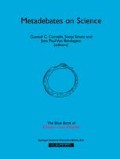Abstract
Juxtaposing the work of Einstein and Magritte has made for a wonderfully diverse and stimulating conference. As Michel Foucault has pointed out, many of Magritte’s works have entertained themes about the openendedness, indeterminateness and complexity of the relations between language, world and imagination. His paintings reveal a world whereby simple objects from our experience are combined in novel ways, providing an elegant way to construct strange new phenomena from the familiar. Einstein, on the other hand, urged us to accept a theory in which it is possible to explain all novelty within a deterministic framework. The theories of relativity show how it is possible to derive a complex world from the geometrical structure of space-time alone. Many things could be said about how we react when asked to think about the relationships between these world-views. And indeed, many imaginative responses have been forthcoming in the course of these proceedings. Unfortunately, I possess neither the time nor the space to say anything more that is immediately about the relationship between the work of these two great artists.
Access this chapter
Tax calculation will be finalised at checkout
Purchases are for personal use only
Preview
Unable to display preview. Download preview PDF.
References
Arthur, W.B., Increasing returns and path dependence in the economy, University of Michigan Press, Ann Arbor, 1994.
Berge, P. et al., Order within chaos, Tuckerman (tr.), Wiley, New York, 1984.
Churchland, P.M. and Hooker, C.A. (eds.), Images of science, University Press, Chicago, 1985.
Dyke, C., “Addition accretion accumulation acceleration alteration: technology and nonlinearity.”, (forthcoming).
Galison, P., How experiments end, University Press, Chicago, 1987.
Garfinkel, A., “A mathematics for physiology”, American journal of physiology, 245, 14, 1983, R455–466.
Giere, R., Explaining science,University Press, Chicago,1988.
Glass, L. and Mackey, M., From clocks to chaos, University Press, Princeton, 1988.
Hacking, I., Representing and intervening, University Press, Cambridge, 1983.
Hooker, C.A., Penfold, H.B., and Evans, R.J., “Cognition under a new control paradigm”, Topoi, 11, 1992, pp. 71–88.
Kourany, J. (ed.), Scientific knowledge, Wadsworth, Belmont, 1987.
Kuhn, T., Structure of scientific revolutions, University Press, Chicago, 1962.
Latour, B., Science in action, Cambridge, Harvard, MA, 1987.
Latour, B. and Woolgar, S., Laboratory life, University Press, Princeton, 1986.
Lorenz, E.N., “Deterministic nonperiodic flow”, Journal of the atmospheric sciences, 20, 1963, pp. 282–93.
Peacocke, A.R., An introduction to the physical chemistry of biological organization, Clarendon, Oxford, 1983
Rapp, P. et al., “Experimental studies of chaotic neural behavior: cellular activity and electroencephalographic signals”, in: Othmer, H.G. (ed.), Nonlinear oscillations in biology and chemistry, Springer-Verlag, Berlin, 1986.
Rosenberg, N., Exploring the black box: technology, economics, and history, University Press, Cambridge, 1994.
Shinbrot, T. et al., “Using small perturbations to control chaos”, in Nature, 363, 1993, pp. 411–417.
Skarda, C. and Freeman, W., “How brains make chaos in order to make sense of the world”, Behavioral and brain sciences, 10, 1987, pp. 161–195.
Stewart, I., Does God play dice? The mathematics of chaos, Basil Blackwell, Oxford, 1989.
Stewart, I., “Warning—handle with care”, Nature, 355, 1992, pp. 16–17.
Van Fraassen, B.C., The scientific image, Clarendon, Oxford, 1980.
Watson, J.D., The double helix, Weidenfield and Nicholson, London, 1968.
Author information
Authors and Affiliations
Editor information
Editors and Affiliations
Rights and permissions
Copyright information
© 1999 Springer Science+Business Media Dordrecht
About this chapter
Cite this chapter
Herfel, W.E. (1999). On Cognitive and Social Dimensions of Science: Constructivism & Nonlinear Dynamics. In: Cornelis, G.C., Smets, S., Van Bendegem, J.P. (eds) Metadebates on Science. EINSTEIN MEETS MAGRITTE: An Interdisciplinary Reflection on Science, Nature, Art, Human Action and Society, vol 6. Springer, Dordrecht. https://doi.org/10.1007/978-94-017-2245-2_7
Download citation
DOI: https://doi.org/10.1007/978-94-017-2245-2_7
Publisher Name: Springer, Dordrecht
Print ISBN: 978-90-481-5242-1
Online ISBN: 978-94-017-2245-2
eBook Packages: Springer Book Archive

